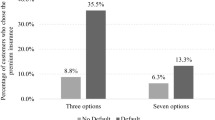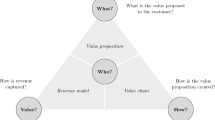Abstract
Many insurance companies offer a huge variety of products within one insurance category. In particular, there are rarely limits to available insurance products in the online world. Insurance companies can simply combine various insurance sums and service components to meet the needs of different customers. Using experimental studies, the paper analyzes the effect of defaults on customer choices and customers’ perceptions of the company when insurance companies offer more or less variety. The results show that defaults have an influence when a smaller, rather than a larger, number of insurance options is available. The premium image of an insurance company can only be influenced by defaults when customers know about the different default settings.
Zusammenfassung
Viele Versicherungsunternehmen bieten ihren Kunden eine große Produktvielfalt an. Vor allem online sind hier kaum Grenzen gesetzt: Durch die Kombination verschiedener Versicherungssummen und Leistungskomponenten können unterschiedliche Kundenbedürfnisse leicht erfüllt werden. In diesem Beitrag wird mittels zweier experimenteller Studien die Wirkung von Voreinstellungen, sog. Defaults, auf das Kaufverhalten von Kunden und deren Wahrnehmung des Versicherungsunternehmens untersucht, wenn Versicherungsunternehmen eine kleinere oder größere Produktauswahl anbieten. Es wird gezeigt, dass Defaults das Kaufverhalten nur dann beeinflussen, wenn eine kleinere Anzahl an Versicherungsprodukten angeboten wird. Die kundenseitige Wahrnehmung des Versicherungsunternehmens als Premium-Anbieter kann nur dann durch Defaults beeinflusst werden, wenn Kunden die verschiedenen Default-Einsatzmöglichkeiten kennen.








Similar content being viewed by others
References
Atalay, A.S., Bodur, H.O., Rasolofoarison, D.: Shining in the center: central gaze cascade effect on product choice. J. Consum. Res. 39(4), 848–866 (2012)
Babin, B.J., Darden, W.R., Griffin, M.: Work and/or fun: measuring hedonic and utilitarian shopping value. J. Consum. Res. 20(4), 644–656 (1994)
Baron, J., Ritov, I.: Reference points and omission bias. Organ. Behav. Hum. Decis. Process. 59(3), 475–498 (1994)
Berger, J., Draganska, M., Simonson, I.: The influence of product variety on brand perception and choice. Mark. Sci. 26(4), 460–472 (2007)
Biswas, D., Grau, S.L.: Consumer choices under product option framing: loss aversion principles or sensitivity to price differentials? Psychol. Mark. 25(5), 399–415 (2008)
Boyd, D.E., Bahn, K.D.: When do large product assortments benefit consumers? An information-processing perspective. J. Retail. 85(3), 288–297 (2009)
Brown, C.L., Krishna, A.: The skeptical shopper: a metacognitive account for the effects of default options on choice. J. Consum. Res. 31(3), 529–539 (2004)
Cai, S., Xu, Y.: Designing product lists for e‑commerce: the effects of sorting on consumer decision making. Int. J. Hum. Comput. Interact. 24(7), 700–721 (2008)
Chernev, A.: When more is less and less is more: the role of ideal point availability and assortment in consumer choice. J. Consum. Res. 30(2), 170–183 (2003a)
Chernev, A.: Product assortment and individual decision processes. J. Pers. Soc. Psychol. 85(1), 151–162 (2003b)
Chernev, A.: Extremeness aversion and attribute-balance effects in choice. J. Consum. Res. 31(2), 249–263 (2004)
Chernev, A.: Product assortment and consumer choice: an interdisciplinary review. Found. Trends Mark. 6(1), 1–61 (2011)
Christenfeld, N.: Choices from identical options. Psychol. Sci. 6(1), 50–55 (1995)
Dhar, R.: Consumer preference for a no-choice option. J. Consum. Res. 24(2), 215–231 (1997)
Diehl, K., Poynor, C.: Great expectations?! Assortment size, expectations, and satisfaction. J. Mark. Res. 47(2), 312–322 (2010)
Diehl, K., Zauberman, G.: Searching ordered sets: evaluations from sequences under search. J. Consum. Res. 31(4), 824–832 (2005)
Grösch, M., Steul-Fischer, M.: Less is more: how the number of insurance options influences customers’ default acceptance. Z. Vers. Wiss. 40(147), 517–529 (2018)
Hanoch, Y., Rice, T., Cummings, J., Wood, S.: How much choice is too much? The case of the medicare prescription drug benefit. Health Serv. Res. 44(4), 1157–1168 (2009)
Haynes, G.A.: Testing the boundaries of the choice overload phenomenon: the effect of number of options and time pressure on decision difficulty and satisfaction. Psychol. Mark. 26(3), 204–212 (2009)
Huffman, C., Kahn, B.E.: Variety for sale: mass customization or mass confusion? J. Retail. 74(4), 491–513 (1998)
Iyengar, S.S., Lepper, M.R.: When choice is demotivating: Can one desire too much of a good thing? J. Pers. Soc. Psychol. 79(6), 995–1006 (2000)
Johnson, E.J., Bellman, S., Lohse, G.L.: Defaults, framing and privacy: why opting in—opting out. Mark. Lett. 13(1), 5–15 (2002)
Johnson, E.J., Hershey, J., Meszaros, J., Kunreuther, H.: Framing, probability distortions, and insurance decisions. J. Risk Uncertain. 7(1), 35–51 (1993)
Kahn, B.E.: Dynamic relationships with customers: high-variety strategies. J. Acad. Mark. Sci. 26(1), 45–53 (1998)
Kahn, B.E., Lehmann, D.R.: Modeling choice among assortments. J. Retail. 67(3), 274–299 (1991)
Kahn, B.E., Wansink, B.: The influence of assortment structure on perceived variety and consumption quantities. J. Consum. Res. 30(4), 519–533 (2004)
Kahneman, D., Knetsch, J.L., Thaler, R.H.: Anomalies: the endowment effect, loss aversion, and status quo bias. J. Econ. Perspect. 5(1), 193–206 (1991)
Levin, I.P., Schreiber, J., Lauriola, M., Gaeth, G.J.: A tale of two pizzas: building up from a basic product versus scaling down from a fully-loaded product. Mark Lett 13(4), 335–344 (2002)
Loewenstein, G.: Is more choice always better. Soc. Secur. Brief 7, 1–8 (1999)
Madrian, B.C., Shea, D.F.: The power of suggestion: inertia in 401 (k) participation and savings behavior. Q. J. Econ. 116(4), 1149–1187 (2001)
Malhotra, N.K.: Information load and consumer decision making. J. Consum. Res. 8(4), 419–430 (1982)
Mogilner, C., Rudnick, T., Iyengar, S.S.: The mere categorization effect: how the presence of categories increases choosers’ perceptions of assortment variety and outcome satisfaction. J. Consum. Res. 35(2), 202–215 (2008)
Nagle, T.T., Holden, R.K.: The strategy and tactics of pricing. A guide to profitable decision making. Prentice Hall, Englewood Cliffs (2002)
Park, C.W., Jun, S.Y., MacInnis, D.J.: Choosing what I want versus rejecting what I do not want: an application of decision framing to product option choice decisions. J. Mark. Res. 37(2), 187–202 (2000)
Quaschning, S., Pandelaere, M., Vermeir, I.: When and why attribute sorting affects attribute weights in decision-making. J. Bus. Res. 67(7), 1530–1536 (2014)
Ritov, I., Baron, J.: Reluctance to vaccinate: omission bias and ambiguity. J. Behav. Decis. Mak. 3(4), 263–277 (1990)
Ritov, I., Baron, J.: Outcome knowledge, regret, and omission bias. Organ. Behav. Hum. Decis. Process. 64(2), 119–127 (1995)
Sagi, A., Friedland, N.: The cost of richness: the effect of the size and diversity of decision sets on post-decision regret. J. Pers. Soc. Psychol. 93(4), 515–524 (2007)
Samuelson, W., Zeckhauser, R.: Status quo bias in decision making. J. Risk Uncertain. 1(1), 7–59 (1988)
Sela, A., Berger, J., Liu, W.: Variety, vice, and virtue: how assortment size influences option choice. J. Consum. Res. 35(6), 941–951 (2009)
Shaw, J.I., Bergen, J.E., Brown, C.A., Gallagher, M.E.: Centrality preferences in choices among similar options. J. Gen. Psychol. 127(2), 157–164 (2000)
Szrek, H.: How the number of options and perceived variety influence choice satisfaction: an experiment with prescription drug plans. Judgm. Decis. Mak. 12(1), 42–59 (2017)
Valenzuela, A., Raghubir, P.: Position-based beliefs: the center-stage effect. J. Consum. Psychol. 19(2), 185–196 (2009)
Author information
Authors and Affiliations
Corresponding author
Appendices
Appendix A
Appendix B
Rights and permissions
About this article
Cite this article
Grösch, M. The impact of product variety on customers’ default acceptance and company perception. Experimental studies for the insurance industry. ZVersWiss 109, 377–398 (2020). https://doi.org/10.1007/s12297-020-00458-w
Received:
Revised:
Accepted:
Published:
Issue Date:
DOI: https://doi.org/10.1007/s12297-020-00458-w




